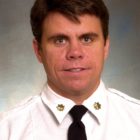
Office of the Mayor
The building where Chief Fahy was killed.
Each year’s solemn commemoration of the September 11 tragedy is a reminder of the enormous price paid that day by the New York City Fire Department. Days like Tuesday are a reminder of a different kind: that the dangers of firefighting aren’t confined to world-altering terrorist attacks. They are present when firefighting personnel respond to the most routine of calls.
Battalion Chief Michael Fahy, with 17 years on the job, was killed Tuesday morning when investigating a possible gas leak at a home in the Kingsbridge section of the Bronx. The house exploded, killing Fahy and injuring 12 others. Published reports indicated that a drug operation of some kind was active at the property.
Fahy was the 1,171st FDNY member killed in the line of duty and the first since Lieutenant Gordon Ambelas in July of 2014. Fahy was the 20th to die since September 11.

FDNY
Battalion Chief Michael Fahy
The FDNY went to 27,403 structural fires last year, down from 30,156 in 1995. But the department also responded to 246,000 non-fire emergencies like gas leaks. That’s 90,000 more than the department handled 20 years ago. In other words, as other parts of the FDNY’s portfolio shrink, others—with their own risks—are growing.
As reported in City Limits’ 2011 series on two decades of firefighter fatalities, each firefighter death is probed by the department’s own Safety Battalion as well as by experts from the Center for Disease Control, with the aim of understanding and learning from each tragedy.
Fahy’s death will be subjected to the same scrutiny. The CDC report on Ambelas’ death came out this past July and pointed to problems like malfunctioning elevators, the absence of a sprinkler system in the building where the tragedy occurred and a lack of “crew integrity.”








